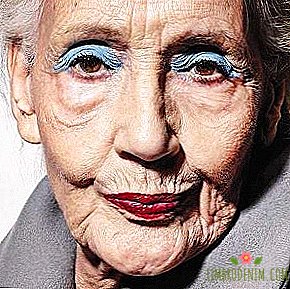Movement - Pain: How I Live With Ehlers-Danlos Syndrome
SCIENCE MOVES FORWARD - FULLY POSSIBLE THAT IN THE FUTURE we will be able to edit the human genome and this will allow to fight hereditary diseases. But, unfortunately, today there are still diseases that are difficult to diagnose and impossible to cure. Alexandra B. told us about life with one of them - Ehlers-Danlos syndrome.

Diagnosis and series "Bones"
Ehlers-Dunloc syndrome (SED) is a genetic disease of the connective tissue. It is caused by defects in the synthesis of collagen - the most important protein of the muscles, blood vessels, bones, cartilage and tendons, external integuments of all organs. Collagen "sticks together" tissue, giving them strength and elasticity - "broken" collagen does not fulfill its duties. The same protein in the form of ampoules or injections does not help: the body does not know what "normal" collagen is and is not able to produce and absorb it. Ligaments do not support joints - because of this, sprains occur. The spine is not fixed in place - as a result, a curvature appears. Most often, people with this syndrome are united by the fragility of blood vessels, the increased flexibility of the joints and the incredible elasticity of the skin, almost like that of Mr. Fantastic. And also - constant pain.
Since childhood, my back hurts. My parents took me to the best surgeons, orthopedists, osteopaths, but everyone said: "You have a curvature of the spine, go swimming." Without sufficient examinations, I was prescribed a treatment that only harmed. For example, physical exercises do not take into account that I have protrusions (this is the first stage of the formation of hernias of intervertebral disks), and they can lead to hernias. Or massages that stimulate blood flow to the lower back, which is forbidden in case of endometriosis (I only learned about what I have and by chance six months ago - although I regularly visited gynecologists for many years and mentioned pain and other symptoms). Practically every doctor reproached me or my parents for not keeping up with my health and bringing it to such a state. Once a surgeon in a district hospital asked me what to do with my back, he answered: "Nothing. Wait for years of pain."
In the fall of 2016, I was at a reception at one of the best vertebrologists. (Specialist in spinal diseases. - Approx. Ed.) Latin America. I met a Mexican and often flew to him; He knew that my back was hurting all the time, and in Russia I could not get a survey, and I wrote it down to a specialist. For two days there, I learned about my condition more than twenty years here. After examination and several X-ray images, the vertebrologist compiled a list of mandatory examinations: magnetic resonance imaging, computed tomography and others.
Everything turned out a year ago, quite by accident, thanks to the show "Bones". There, one of the victims had Ehlers syndrome - Danlos - and the same symptoms as mine
Back in Moscow, for three months I tried to get a referral for an MRI. When a neurologist called the most experienced Mexican vertebrologist a fool, my patience snapped. I went to the hospital manager, but she said that I would never get a referral for an MRI of the spine, because they are forbidden to appoint such a volumetric analysis. Only after I had burst into tears, she took pity on me and gave direction to the tomography of one section of the spine, although I needed to examine four. After that, I never used free medicine again.
Everything turned out a year ago, quite by accident, thanks to the show "Bones". There, one of the victims had Ehlers syndrome - Danlos - and the same symptoms as mine. I was surprised at the similarity, read about the disease on the Internet and enrolled in genetics in Moscow - the only Russian specialist who attends international conferences dedicated to EDS. I came to the reception with a folder of analyzes and conclusions of all possible specialists. The doctor examined them, asked about the relatives' diseases, examined me and confirmed my assumption, making the diagnosis Ehlers-Danlos syndrome. On the one hand, I was relieved: finally, I know that with me, it will be easier for me to control the disease. On the other hand, the diagnosis sounded like a sentence, since the SED is incurable. The geneticist comforted that hypermobility will decrease with age. But, unfortunately, other chronic diseases caused by the syndrome will not disappear anywhere.

Life with a syndrome
The probability of inheritance of Ehlers-Danlos syndrome is fifty percent; such a fun lottery. Most likely, my mother has it: she has the same problems and pains, but she was not examined. There are six types of Ehlers-Danlos syndrome, each with a different mutation of certain genes. For example, in people with a classic type, the skin is incredibly elastic and stretchable, and in people with vascular skin, fragile vessels can reach the rupture of arteries.
I have a hypermobile type of SED - this is found in one in ten to fifteen thousand people. With it, you can easily damage any joint: fingers, knee, maxillary. Scientists have still not found the gene responsible for the mutation in this case, which means that the disease cannot be identified with the help of tests. The probability that my children will have the syndrome is also about fifty to fifty, but it seems to me even higher: I read in English-speaking groups that almost all people with the syndrome have been transmitted to children. Plus, at SED, pregnancy and childbirth are extremely difficult - a geneticist told me about this, but I listened half-heartedly, since I do not plan to have children.
Ehlers-Danlos Syndrome is accompanied by diseases of all organs with connective tissue, as well as other problems related to the functions of these organs. I have chronic inflammation of the tendons of the legs, chronic headaches and chronic otitis media, endometriosis, curvature of the spine with protrusions and degradation of intervertebral discs. There are problems with the gastrointestinal tract, hearing, vessels, skin: irritation, redness, reaction to cold and heat, eternal dryness, persistent rash, scars from scratches.
People with my diagnosis are prone to depression due to chronic pain: it is hard to endure and realize that over the years it will only get worse
Every day my head, neck and lower back hurt because of the curvature of the spine and improper distribution of the load when walking. Ankle joints hurt due to too high mobility, regular injuries occur. I cannot walk without insoles even at home, otherwise my legs will turn out.
Due to improper development of connective tissue, it was necessary to align the teeth. I am also allergic to countless substances: antibiotics, dyes, preservatives. Because of chronic fatigue syndrome, I cannot even master this interview - the young man types the answers from dictation. Immunity is not a damn thing either: in twenty two years I had bronchitis (it was not easy to cure him without antibiotics), and angina, and autoimmune disease, and many other conditions. People with my diagnosis are prone to depression because of chronic pain: it is hard to endure and realize that over the years it will only get worse.
The list of my diseases is constantly updated. More than six months ago, during the next examination, I noticed that I have poor blood test results and the indicators are getting worse. Since then, trying to figure out what's wrong. It seems to me that I have already bypassed all more or less good doctors in Moscow - but no one knows the specifics of patients with SED, and they must be taken into account in order to make a correct diagnosis. Therefore, no one can help me, or at least direct me to the necessary analyzes. Most often, doctors simply do not believe that I have the syndrome at all - although I always carry the conclusion of genetics with me. Constant going to the doctors is crazy.

Limitations and overcomes
Unlike the USA, Great Britain, France, Mexico and other countries, in Russia with Ehlers-Danlos syndrome they do not give a disability, neither in one of the comorbid diseases either. The state does not help, I can not achieve the imputed treatment or examinations. I have so many illnesses that there is no extra money, and I would be glad not to pay ten thousand for blood tests. Or to be able to park in places for people with disabilities, which are located closer to the entrance to the building - even such a small amount helps when you need to get somewhere during a painful attack. For a year, unsuccessfully trying to find a doctor who could lead me, help and correct the treatment of concomitant diseases. But in Russia there are only two or three specialist genetics on the SED. There are no Russian-speaking support groups, so I am in English-speaking groups on Facebook.
SED gives not only pain, but also a hypersensitive reaction to it: even such an insignificant thing as, for example, blood donation, drives me crazy. In childhood it was especially hard. Pain takes all the energy: any action is worth the enormous effort. Strong attacks of nausea, breathing, dizzy, hard to talk. Sometimes tablets partially remove the condition, but most often not. I always carry a complete set with me: ordinary painkillers, a very strong painkiller for emergency situations, several types of muscle relaxants.
Some things I can't do in principle, as they bring a lot of pain: get out for a long time, carry food home from the store, move and shift things, get something from the upper shelves. There are cases that sometimes work out, sometimes not - this is cooking, loading the dishwasher (without which I find it very difficult), washing. If a good day falls, I try to do a little more than usual. But I always keep an eye on the load - I recently took out clothes in the closet for several hours, and then I could not get out of bed for a week. Of good: all the men with whom I was in a relationship, always took most of the homework for themselves.
Pain takes all the energy: any action is worth the enormous effort. Severe pain makes you sick, breathing hard, dizzy, hard to talk
My life consists of limitations and overcomes. Constantly have to control themselves, so as not to be injured. I can not go to the baths and saunas, run and do everything that gives a strong load on the spine. As a child, I was involved in equestrian sports and always dreamed of returning to it, but it was forbidden to me. For several years I practiced yoga, the teachers were surprised by my flexibility - it is typical of the SED. I love to swim, and now this is the only thing that helps me reduce pain. Raise heavy objects, bend over, walk for a long time - not for me. Five years ago, I adored long walks in the city, now it is impossible: almost immediately there is a strong back pain that does not go away for several days.
I am a lawyer by my first education, but a few years ago I changed my profession and received another diploma - a teacher of Russian as a foreign language. There were many reasons, but the impetus was the fact that lawyers have sedentary work. And I can not sit long: my back starts to hurt badly. Now I do what I love, and at the same time I can devote enough time to health. I love to work, and I can’t imagine my life without it, but I need to clearly prioritize. As a teacher, I myself make the schedule, given the time for training. I go to the pool at least two or three times a week, and I also study at home or in the hall according to a special program. If I work in the morning, I take the second under sports and recreation.
Being visible and communicating with people in moments of pain is inevitable. At work, I need to constantly look interested and energetic - with chronic pain it is hard. Then I take the medicine and work on. I learned to express emotions that I do not feel. My colleagues are sure that I am always in a good mood, although in reality it is rare in moments of pain. Friends know how I feel, but, it seems to me, they think that I embellish, and they don’t know how badly I feel. A healthy person is really hard to understand what I am experiencing.
Thanks to my condition, I have excellent will power: I can get up early in the morning at the weekend to go to the gym, force myself to do something, even if I don’t want
What scares me most is that with age, problems with the spine will only worsen: due to curvature, the load is distributed incorrectly and natural wear accelerates - a hernia of the intervertebral disk may occur or nerve pinched can occur if you do not practice therapeutic exercises. It is terrible to think what will happen in twenty years, if now I feel bad.
On the other hand, this fear motivates to do something now: engage in permitted sports, work, travel. As in any situation, in life with a chronic syndrome there is not only a negative. Thanks to my condition, I have excellent will power: I can get up early on the weekend to go to the gym, force myself to do something, even if I don’t want to. I clearly understand when I need to rest and relax to feel better, and when I'm just lazy. Because of regular workouts, I have a strong, trained body, I can work on myself. And due to the fact that I occasionally feel bad, I do not save for later something important and interesting. If I want to learn new things, I immediately do it. For example, recently went to Latin American dances. The syndrome also taught me how to relate easier to life and to myself: everyone has peculiarities - and mine only make me stronger.
Photo:salita2010 - stock.adobe.com (1, 2, 3)





